|
|
PassifloraFamily: Passifloraceae.
|
Common name(s): Granadilla, Passionflower |
Passiflora caerulea |
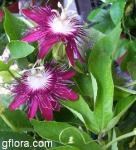 |
Genus of more than 400 species of mostly evergreen tendril climbers, and a few annuals, perennials, shrubs and trees, occuring in tropical woodland, on rocks, and in grassland, in tropical North, Central and South America, in tropical Asia, Australia, New Zealand, and the Pacific islands. The Passiflora is a tropical-looking, short-lived, waxy flowers grow on these rapid-growing, evergreen or deciduous vines grown outdoors only in the southernmost U.S. Parts of the short-lived flowers are said to represent elements in the biblical story of Jesus' Passion. Varieties include the popular Blue Passionflower (P. Caerulea), which is nearly immune to pests and is less affected by frost. P. Alatocaerulea, which has been used in perfume, has fragrant, white flowers, tinted pink and lavender with deep blue or purple crowns. Vines reach 20 to 30 ft. tall. Vigorous growth can become a tangle of new and old vines, so thin each spring after second year and support vines on trellises or fences. Likes full sun to partial shade. |
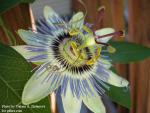 |
| Growing conditions |
Watering and misting |
Propagation |
| Average warmth in summer - minimum 55F in winter.Brightly lit spot. Grow in soil-based potting mix. |
Keep compost moist at all times but never waterlogged. Reduce watering in winter. Use soft, tepid water. Misting is necessary. |
Take stem cuttings in spring. Sow seed at 55-64 F (13-18 C) in spring. Layer in spring or autumn. |
|
Passiflora edulis |
|
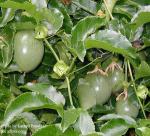 |
Common Names: Passion Fruit, Granadilla, Purple Granadilla, Maracuya
The purple passion fruit is native from southern Brazil through Paraguay to northern Argentina. The purple passion fruit is subtropical and prefers a frost-free climate. However, there are cultivars that can take temperatures into the upper 20's (°F) without serious damage. The plant is widely grown in California as far north as San Jose, the Monterey Bay Area and the San Franciso Bay Area. The vines may lose some of their leaves in cool winters. The plant performs well indoors.
The passion fruit is a vigorous, climbing vine that clings by tendrils to almost any support. It can grow 15 to 20 ft. per year once established and must have strong support. It is generally short-lived (5 to 7 years). The evergreen leaves of passion fruit are alternate, deeply 3-lobed when mature and finely toothed. They are 3 to 8 inches long, deep green and glossy above, paler and dull beneath and, like the young stems and tendrils, tinged with red or purple.
A single, fragrant flower, 2 to 3 inches wide, is born at each node on the new growth. Purple passion fruit is self-fruitful, but pollination is best under humid conditions.
The nearly round or ovoid fruit, 1-1/2 to 3 inches wide, has a tough rind that is smooth and waxy and ranging in hue from dark purple with faint, fine white specks, to light yellow or pumpkin-color. Within is a cavity more or less filled with an aromatic mass of double walled, membranous sacs containing orange-colored, pulpy juice and as many as 250 small, hard, dark brown or black, pitted seeds. The unique flavor is appealing, musky, guava-like and sweet/tart to tart. The vine is fast-growing and will begin to bear in 1 to 3 years. Ripening occurs 70 to 80 days after pollination.
Seed planted soon after removal from the fruit will germinate in 10 to 20 days. Cleaned and stored seeds have a lower and slower rate of germination. Seeds should be planted 1/2 to 1 inch deep in beds, and seedlings may be transplanted when 10 inches high. |
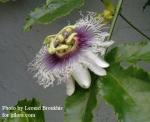 |
|
Passiflora lutea |
|
|
This interesting plant can be found in the southern half of Missouri. The plant is easy to identify in the field because of its 3-lobed leaves, vining habit, and small yellowish flowers. The species epithet "lutea" means "yellow." |
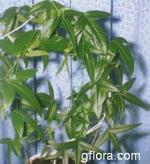 |
|
Passiflora victoria |
|
|
Fantastic climbing plant that is laden with spectacular flowers all summer long. It also produces fruit with delicious sweet flesh. It can be grown in a large patio pot or in the garden. |
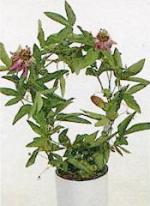 |
User-submitted additions and corrections:
Mrs.Gordon
Germany
23rd May 2010
|
i have one of these (it looks like the blue one in the top right corner of this page) very pretty , when i got mine from the store it was wraped arond a plastic thing makeing the vine go into a circle . when i got it home i re-planyed and took mine off the circle thing(the vine was much much longer than it looked) i placed mine where it would framed my kitchen window it is very pretty when it blooms (it is not in direct sunlight ) |
|





